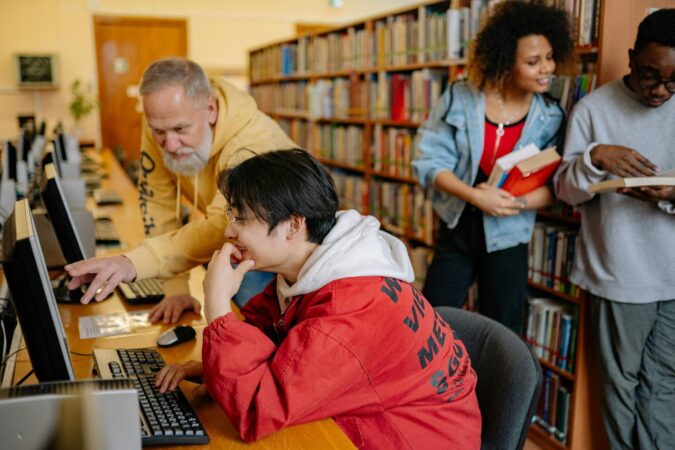
Every workplace is full of brilliant people, each with their own unique way of thinking. Yet, for too long, we’ve operated on the assumption that everyone’s brain works the same way, expecting a single, standardized approach to tasks like note-taking, organization, and communication. This is a flawed premise that leaves a great deal of talent on the sidelines. We’re missing out on the unique creativity and problem-solving skills that neurodiverse individuals, including those with learning disabilities, bring to the table. The truth is, a neurodivergent brain is not a broken brain; it’s just wired differently. The real challenge often lies not within the individual, but within a work environment that isn’t designed to support them. This is where assistive technology (AT) comes in. It’s not about providing a crutch; it’s about giving a ladder. AT bridges the gap between how a person thinks and how a task is traditionally performed, creating a more level playing field for everyone. This effort toward digital inclusion at work is about unlocking potential and fostering an environment where every employee can genuinely thrive.
Understanding the Landscape: Common Workplace Challenges for Adults with Learning Disabilities
Let’s get specific. What does a day at the office actually look like for an adult with a learning disability? Consider someone with dyslexia. Reading a long, dense report might not be a quick skim; it could be a physically and mentally exhausting marathon, where words swim on the page and paragraphs lose all meaning. It takes extra time and intense focus just to process the information, leaving them drained for the rest of the day. For an individual with ADHD, a cluttered email inbox or a chaotic project folder can feel like walking into a crowded room with a dozen people all trying to talk to you at once. Prioritizing tasks becomes a monumental effort, and a simple distraction can derail an entire afternoon’s work. It’s a constant battle against a brain that craves stimulation but struggles with consistent attention.
Then there’s dyscalculia, which turns numbers into an enemy. Everything from basic budgeting to analyzing spreadsheets becomes a daunting task filled with anxiety and potential errors. These aren’t just minor inconveniences; they are significant, daily hurdles that can impact performance reviews, prevent promotions, and erode a person’s self-confidence over time. The workplace, built for the neurotypical mind, can feel like a series of hidden traps and inaccessible pathways. Without the right tools, these individuals are forced to work ten times as hard just to keep up, leaving them with little energy to innovate and contribute in the meaningful ways they are capable of.
The Core of Assistive Technology: Categories and Tools
So, what’s the solution? Assistive technology isn’t a single product; it’s an entire ecosystem of software and hardware designed to make the digital world more manageable. Think of it as a personalized toolkit. We can break down this ecosystem into a few key categories, each one targeting a specific cognitive challenge. It’s like having a specialized tool for every job: a screwdriver for a screw, a hammer for a nail, and so on.
First, you have tools for language and reading. These technologies help with the fundamental processes of consuming and producing information. Then there are the organizational tools, which are essentially a person’s digital “executive assistant,” handling the nitty-gritty of scheduling and task management. Finally, there are the writing aids, which help to get thoughts from brain to page, ensuring clarity and coherence. Each category is built on the same core principle: removing the barrier, not fixing the person. The goal is to empower the user, giving them a seamless way to work, rather than forcing them into an outdated, one-size-fits-all mold. By understanding these categories, we can see how powerful this technology can be.
Text-to-Speech and Speech-to-Text Solutions
When it comes to communication, many of us still rely heavily on reading and writing, two processes that can be incredibly challenging for those with dyslexia. This is where vocal-based technologies step in to change the game completely. Text-to-speech (TTS) software, for example, transforms digital text into spoken words. You can simply highlight an email, a report, or a legal document, and a synthesized voice will read it aloud to you. This is a game-changer. It bypasses the struggle of visual decoding and allows a person to consume information auditorily, freeing up their cognitive resources to focus on comprehension and critical thinking.
On the flip side, there’s speech-to-text (STT) technology, also known as dictation software. This is a lifesaver for people who find typing or spelling difficult. Instead of laboriously pecking out an email or a draft of a memo, you can simply speak your thoughts, and the software translates them directly into text. Think of it as a personal scribe. You can dictate entire reports, client summaries, or even quick notes without worrying about typos or grammar. This not only dramatically increases a person’s writing speed but also helps to get creative ideas out without the frustration of the mechanical act of writing.
Organization and Time Management Apps
Let’s talk about executive function. This is a term we hear a lot in discussions about ADHD, and it refers to the set of skills we use to manage our lives: organizing tasks, prioritizing, and managing time. For many with ADHD, these skills don’t come naturally, and the constant stream of deadlines, meetings, and to-dos can feel like trying to catch water with your hands. That’s why organization and time management apps are so essential. They act as a reliable external brain, providing the structure and reminders that a person’s internal systems might be lacking.
These digital tools are not just fancy to-do lists; they are comprehensive systems designed to keep you on track. They can help you break down a large project into small, manageable steps, a strategy that is vital for preventing a feeling of being overwhelmed. They can also provide gentle nudges and reminders exactly when you need them, ensuring that deadlines aren’t missed and essential tasks don’t fall through the cracks. They give people the ability to visualize their workload and schedule in a way that makes sense to them, reducing the mental chaos.
Here are just a few examples of tools that can make a world of difference:
- Project Management Platforms: Tools like Trello or Asana that provide visual, customizable boards to track tasks and projects. These can be set up to show progress at a glance, making it easy to see what’s done, what’s in progress, and what’s next.
- Digital Planners and Calendars: Apps such as Google Calendar or Notion that help with scheduling, setting deadlines, and organizing daily routines. These can be configured to send alerts and reminders for meetings and critical due dates.
- Time-Tracking and Focus Apps: Software like Pomodoro timers or distraction blockers that help users stay on task and manage work sessions by breaking them into manageable intervals with built-in breaks.

Note-Taking and Writing Assistance
For some, the struggle isn’t in understanding information but in capturing and communicating it. You might have the best ideas in the world, but if you can’t get them down on paper in a clear and organized way, they can go to waste. This is a common issue for many with learning disabilities. Fortunately, modern technology has a lot to offer here as well. Think of smartpens, which can digitize your handwritten notes in real-time, making them searchable and easier to organize. You can write your notes in a physical notebook and have them instantly appear on your computer, ready to be edited or shared.
And then there are AI-powered writing assistants. These tools go far beyond simple spell-check. They can provide real-time feedback on your grammar, tone, and clarity. They can suggest alternative phrasing, help you restructure sentences, and even identify sections where your writing might be too complex or confusing. It’s like having a kind and patient editor sitting right next to you, giving you tips and advice as you write. These tools don’t just correct mistakes; they teach you how to be a better writer, building your skills and confidence over time.
Implementing Digital Inclusion at Work: Best Practices and Corporate Responsibility
Now, for the big question: how do we get this done? It’s one thing to know about the tools; it’s another to make them a reality in the workplace. This isn’t just about an employee asking for a tool; it’s about a company actively creating a culture of inclusion. The most successful implementations of AT happen when the employer takes a proactive and supportive approach.
Best practices start with awareness. Companies should educate their managers and HR departments about learning disabilities and the role that AT can play. This helps to remove the stigma and fosters a sense of psychological safety. Employees should feel comfortable discussing their needs without fear of judgment. Employers should also have a transparent, easy-to-follow process for requesting and obtaining assistive technology. It shouldn’t be a bureaucratic nightmare. The company can even provide a “menu” of pre-approved tools to streamline the process. Finally, providing training on how to use the AT effectively is crucial. Handing someone a piece of software without showing them how to use it is like giving them a car without a lesson. True inclusion requires a thoughtful, end-to-end approach, from the initial conversation to ongoing support.
Conclusion
In the end, assistive technology isn’t just a series of products; it’s a mindset. It’s the belief that talent comes in many forms, and that a truly innovative and productive workforce embraces every single form it takes. AT is a powerful tool for empowerment, enabling professionals to overcome daily challenges and focus on what they do best. By providing these tools, businesses don’t just meet a legal or ethical obligation; they make a strategic investment in their people. They build a more resilient, diverse, and ultimately, more successful organization. The future of work is not about forcing everyone to fit a single mold; it’s about building a world where every individual has the tools they need to shine. That is the true meaning of digital inclusion at work.